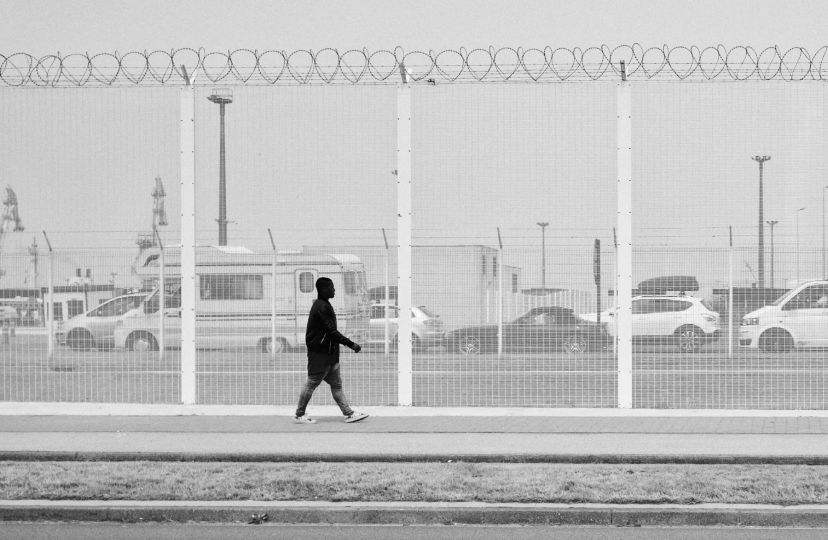Published by sun/sun éditions, Le Bruissement entre les Murs is a new example of the magic that can emerge from the meeting of two visual languages. This collaboration between Clara Chichin and Sabatina Leccia was made possible by the Transverse 2022 grant, which encourages breaking down barriers in photographic practice by fostering dialogue with an artist from another discipline.
Clara Chichin is a photographer interested in our relationship with nature, landscapes, and their representation. This subject also resonates with Sabatina Leccia, an artist working at the intersection of art and craft. She embroiders her drawings to create “landscapes or interior cartographies.” Le Bruissement entre les Murs was born from their shared desire to explore nature within an urban environment. Both residents of Montreuil, they turned to a historic site in the city: the Murs à pêches (Peach tre Walls).
Erected in the 17th century, these plots were a true innovation. Their walls, made of earth and flint, regulated the temperature, allowing peaches a Mediterranean fruit to grow in the Paris region. Although much of the land was lost due to railway expansion and urbanization projects, a portion was preserved as a classified heritage site and continues to resist today. This area now represents a 35-hectare green lung for eastern Paris and a heritage treasure to be safeguarded.
Beneath a delicately handcrafted washi paper cover, the book opens with an aerial view of the Murs à pêches, whose winding lines resemble the veins of a leaf. Clara Chichin and Sabatina Leccia immersed themselves in this labyrinth, wandering through it regularly to absorb its rich history while observing the natural life that goes on: “the slow rhythm of the living,” a pace they adopted for the project. “We wanted to be in another rhythm, one where we could dream, without immediately worrying about production or productivity. We wanted to let the experience of these walks and the metamorphosis of the landscape to penetrate within us.”
Through their walks, the two artists grew familiar with the place. Chichin captured it with her camera, while Leccia gathered materials, such as plant extracts, for creating pigments. Their practices then converged, incorporating processes like developing images on textiles, working with colors, and creating compositions that evolved with nature itself. “There is a relationship between texture and the transformation of images that changes with the seasons.” Day by day, page by page, the garden metamorphoses. The images, reworked, dyed, sewn, embroidered, and perforated, form a poetic and sensory cartography where nature oscillates between reality and an imaginary world—a transcendent, ever-changing vision that also echoes the many transformations imposed on this site throughout history.
Le Bruissement entre les Murs is a work imbued with rare poetry. Its sensory power serves as a remedy to the “crisis of sensitivity” in our contemporary world, which art historian Estelle Zhong Mengal links to the ecological crisis. She writes that modernity has severed our connection to the sensory world. For Chichin and Leccia, the political message is a poetic one. If their slow wanderings through nature offer a way to “reweave sensitivity between humans and the living,” they are also an invitation to dream—dreaming as a final refuge, as the last space of resistance.
Clara Chichin and Sabatina Leccia – Le Bruissement entre les Murs
Published by sun/sun éditions
Dimensions: 17 x 22 cm
112 pages
Arena Ivory Bulk 90g paper
Offset printing
70 four-color images + 8 risograph inserts
Swiss binding with a risograph-printed cover
ISBN: 979-10-95233-52-7
Available online and in all good bookstores.
Collector’s Edition (15 copies):
Handmade washi paper cover crafted by the Atelier Papetier, risograph-printed by Atelier du Palais, vegetable dyeing by Ludovic de Valon, perforated by Sabatina Leccia, and manually bound by Atelier Dédale Dedans.
Special Edition (170 copies):
Handmade washi paper cover crafted by the Atelier Papetier and risograph-printed.
This project received the Transverse Grant funded by ADAGP and Freelens. Clara Chichin also benefited from a writing grant from the Nouvelle-Aquitaine Region, and the book was supported by the Occitanie Region.



















